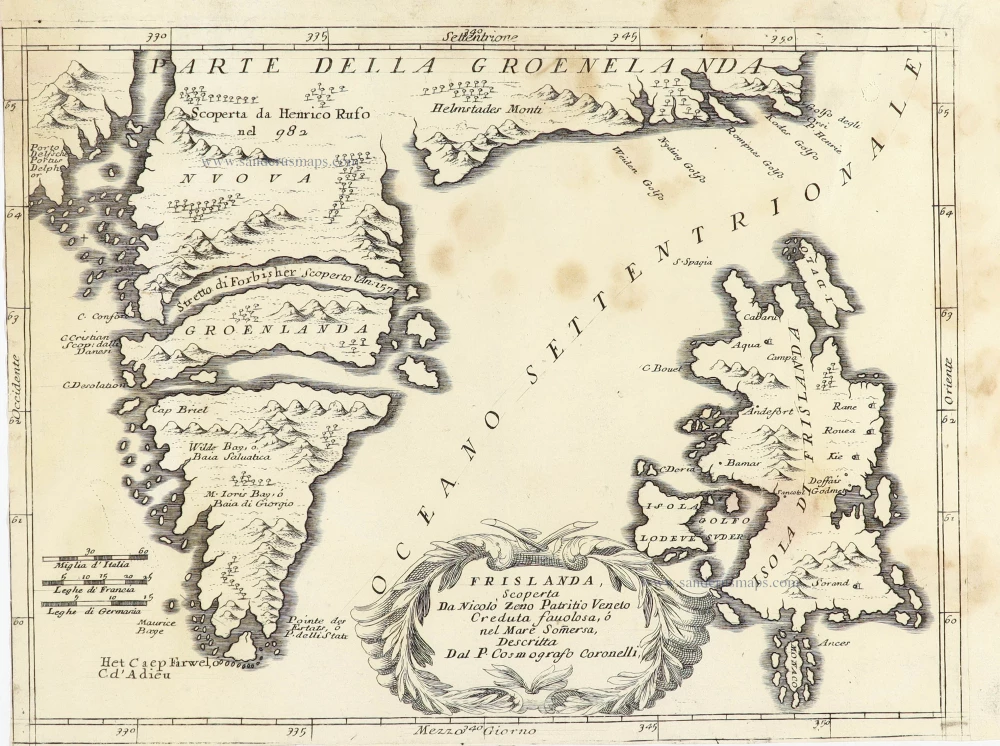The imaginary island Frisland, by Vincenzo Coronelli. 1692
Frisland is a phantom island that appeared on virtually all of the maps of the North Atlantic from the 1560s through the 1660s. It seems to have been born out of the confusion between an imaginary island and the genuine southern part of Greenland. Frisland originally may also have been a cartographic approximation of Iceland. Still, in 1558 the influential Zeno map charted the landmass as an entirely separate island south (or occasionally southwest) of Iceland.
Vincenzo Coronelli (1650-1718)
Vincenzo Coronelli was born in Venice on 16 August 1650 and primarily brought up in Ravenna. He returned to Venice in 1665 and joined the convent of the Minor Conventuals. Five years later, he was sent to Rome to study, and by 1673, he was already a doctor of theology.
Having achieved fame by constructing two globes for the Duke of Parma, he was invited to Paris for three years in 1681 and made two enormous examples for Louis XIV. On his return to Venice, he assiduously collected cartographic material and founded the Academy of the Argonauts. In 1685, he was appointed Cosmographer to the Republic of Venice and authorised to publish a large atlas. He became a geography lecturer at the University of Venice and brought out an Atlante Veneto the following year.
In 1696, he visited Germany, Holland and southern England. During intervals in compiling his vast encyclopaedia, he continued with cartographic projects up to 1709. He died in his native Venice on 9 December 1718.
Coronelli became famous for his globes. In addition, he was a renowned encyclopaedist, mapmaker and geographer. Most of his maps and other material are gathered in his Atlante Veneto (13 vols, 1690-1705). The first volume, subtitled Descrizione generale istorica geografica, was his masterpiece, planned as an extension of Blaeu’s atlas.
Other volumes of the atlas which contain maps are Isolario, two parts (1696-8), with detailed maps and plans, mostly of islands; Corso geografico, two parts based on the edition 1694-7; Libro de’ globi (1697); and Lo Specchio del Mare, a reprint of Levanto's Lo Specchio del Mare Mediterraneo of 1664.
The other vital aspects of his mapping are those arising from the Venetian conquest and his travels. His most extensive military compilation was the Teatro della Guerra, in more than 30 volumes.
Frislanda,
Item Number: 29221 Authenticity Guarantee
Category: Antique maps > America > North America
Antique map of the imaginary island Frisland, by Vincenzo Coronelli.
Title: Frislanda,
Frislanda, Scoperta Da Nicolo Zeno Patritio Veneto Creduta favolosa, ò nel Mare Somersa,
Descitta Dal P. Cosmografo Coronelli.
Date of the first edition: 1692.
Date of this map: 1692.
Copper engraving, printed on paper.
Image size: 230 x 300mm (9.06 x 11.81 inches).
Sheet size: 240 x 320mm (9.45 x 12.6 inches).
Verso: Blank.
Condition: Stained, short left and bottom margins.
Condition Rating: B+.
From: Corso Geografico Universelle. Venice, 1692.
Frisland is a phantom island that appeared on virtually all of the maps of the North Atlantic from the 1560s through the 1660s. It seems to have been born out of the confusion between an imaginary island and the genuine southern part of Greenland. Frisland originally may also have been a cartographic approximation of Iceland. Still, in 1558 the influential Zeno map charted the landmass as an entirely separate island south (or occasionally southwest) of Iceland.
Vincenzo Coronelli (1650-1718)
Vincenzo Coronelli was born in Venice on 16 August 1650 and primarily brought up in Ravenna. He returned to Venice in 1665 and joined the convent of the Minor Conventuals. Five years later, he was sent to Rome to study, and by 1673, he was already a doctor of theology.
Having achieved fame by constructing two globes for the Duke of Parma, he was invited to Paris for three years in 1681 and made two enormous examples for Louis XIV. On his return to Venice, he assiduously collected cartographic material and founded the Academy of the Argonauts. In 1685, he was appointed Cosmographer to the Republic of Venice and authorised to publish a large atlas. He became a geography lecturer at the University of Venice and brought out an Atlante Veneto the following year.
In 1696, he visited Germany, Holland and southern England. During intervals in compiling his vast encyclopaedia, he continued with cartographic projects up to 1709. He died in his native Venice on 9 December 1718.
Coronelli became famous for his globes. In addition, he was a renowned encyclopaedist, mapmaker and geographer. Most of his maps and other material are gathered in his Atlante Veneto (13 vols, 1690-1705). The first volume, subtitled Descrizione generale istorica geografica, was his masterpiece, planned as an extension of Blaeu’s atlas.
Other volumes of the atlas which contain maps are Isolario, two parts (1696-8), with detailed maps and plans, mostly of islands; Corso geografico, two parts based on the edition 1694-7; Libro de’ globi (1697); and Lo Specchio del Mare, a reprint of Levanto's Lo Specchio del Mare Mediterraneo of 1664.
The other vital aspects of his mapping are those arising from the Venetian conquest and his travels. His most extensive military compilation was the Teatro della Guerra, in more than 30 volumes.

